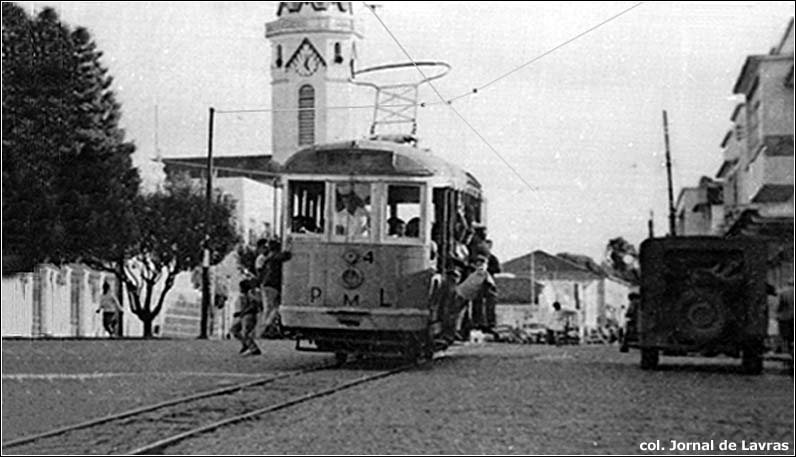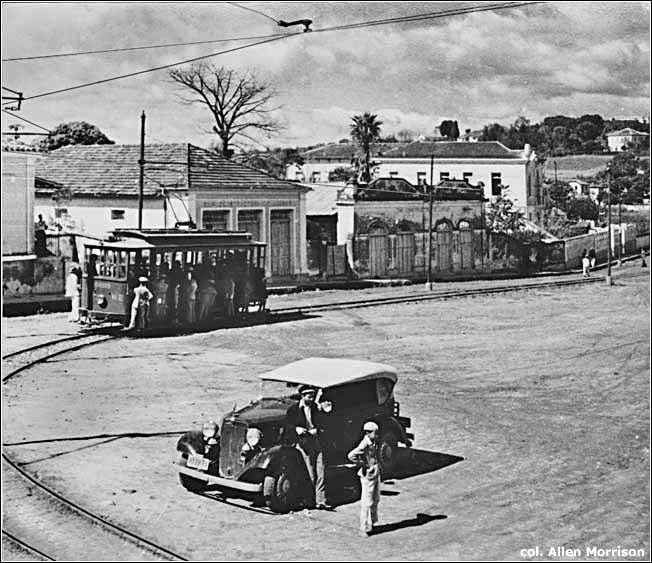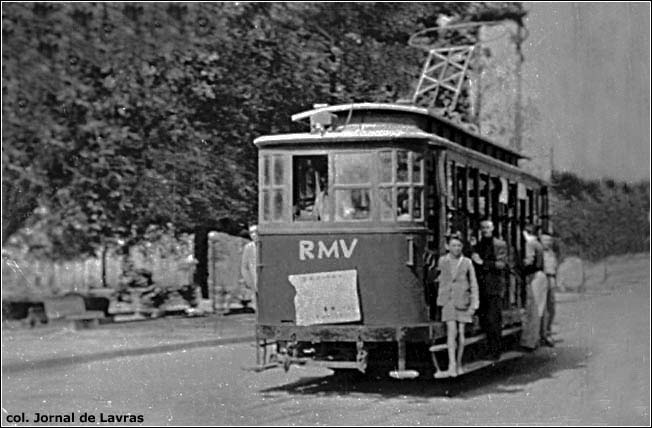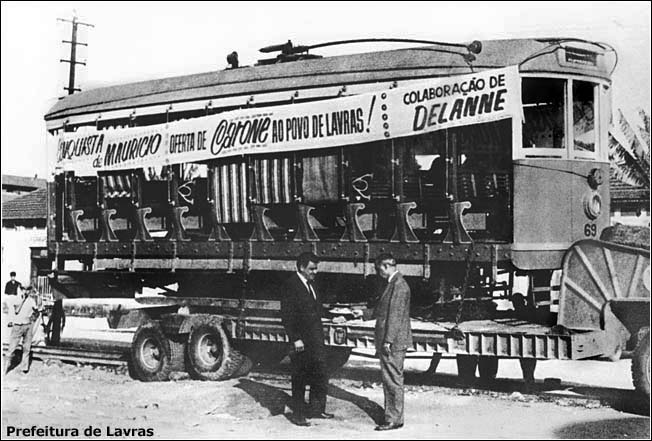LAVRAS
Minas Gerais state
BRAZIL
BY
Allen Morrison
Transport experts have long admired the open toastrack tram as one of the best vehicles ever devised: user-friendly, non-polluting, naturally air-conditioned, quick to load, enjoyable to ride. Brazil had more open trams than any other place and no city displayed their virtues better than Lavras. Like many towns in Minas Gerais ("General Mines"), Lavras ("Excavations"), 230 km southwest of Belo Horizonte, attracted prospectors during the Brazilian gold rush of the early 18th century. (Brazil had the world's first recorded gold rush.) It became an agriculture center in the 19th century and prospered at the junction of two railroads: the Rede de Viação Sul Mineira, which ran southwest from Lavras toward São Paulo, and the Estrada de Ferro Oeste de Minas, which connected Angra dos Reis (Rio de Janeiro state) with Belo Horizonte. Today it is a university town full of young people and, among other things, claims the highest literacy rate in the state. Population was 25,000 in 1910 and is about 100,000 today. The city lies on a ridge sloping upward, south, from the railroad station in the valley [see map]. To take its passengers up the long grade into town, the EFOM built an electric tram line in 1910 and acquired two 2-axle 11-bench cars from Waggonfabrik Falkenried in Hamburg, Germany. This photograph shows one of them at the Falkenried factory before it was shipped to Brazil [Siemens-Museum, München]:
|

Closeup of the scene above. Note the steam railroad's initials, "EFOM", on the front. A child ran too fast for the camera's slow lens [col AM]:
Another early view of the "ESTAÇÃO DE BONDES " - the tram waiting station at Praça Barão de Lavras [see map] [col. Ricardo Resende Coimbra]:
The northern end of the line in front of the railroad station [see map]. View is south. The tramway loop around the praça in front of the station had not yet been built. This part of the city was still undeveloped when the tramway opened. But, largely because of it, this hillside will populate rapidly [col. Ricardo Resende Coimbra]:
Av. Pedro Salles, the same spot a few years later [see map]. The photographer was probably on the roof of the railroad station. Ribeirão Vermelho flows under the small bridge at the bottom of the valley (marked by the trees). The large building with the walled yard on the left was the home of EFOM's chief engineer [col. Ricardo Resende Coimbra]:
The next picture shows car 2 on the new loop at the railroad station [see map]. The house with the walled yard seen in the previous picture is on the right here. Rather than "EFOM", this tram is marked "OESTE". Perhaps the passenger(s) that missed it will take this taxi [col. AM]:
The railroad station. Trams seem always to have circled the loop in a clockwise direction [col. Ricardo Resende Coimbra]:
Traveling south, up the hill, into the city [see map] [col. Museu de Lavras]:
This advertisement for the "Salão Elite" barber shop boasts that it is located "em fremte à est. de bonds" = in front of the tram station [see map]. The word bonde (tram) was formerly written bond [col. AM]:
|

This derailment on Rua Pedro Salles was a "guy thing" [see map] [col. Museu de Lavras]:
|

Happy times had returned to town [col. Jornal de Lavras]:

Closeup of the scene above [col. Jornal de Lavras]:
|

The picture below of an ex-Belo Horizonte tram in Lavras [made from a color slide duplicate] was taken by U.S. rail enthusiast Donald Nevin during a visit in 1965 [Donald Nevin]: |

Another picture taken by the visitor in 1965 [Donald Nevin]:
|

The tram route was shortened a few blocks in later years: instead of Rua João Modesto, cars terminated at Praça dos Trabalhadores [see map]. The photograph below was taken from the window of a tram sitting at the new terminus. View is north, down Rua Francisco Salles [Donald Nevin]:
An anonymous newspaper text from about 1970 [col. Museu de Lavras]:
"NOSTALGIA ON RAILS. Lavras once had a tramway that went up and down its hilly main street. Youngsters called the two vehicles Fuca and Cupa and tagged alongside the slow-moving contraptions of which only curious and nostalgic memories remain today. Nobody remembered to save a tram in Lavras as a living document of an era. And it's only now that Museu de Lavras will have a permanent location since MEC is interested in the collection of Bi Moreira, a man who breathes the past and always dreamt of keeping it alive for the people of Lavras." It was perhaps Bi Moreira (full name: Sílvio do Amaral Moreira) that took some of the photographs shown on this page. The poster below promoted an exhibit in 1981 [col. Museu de Lavras]:
Museu de Lavras was renamed Museu Bi Moreira in 1983. The photograph below shows the only (known) trace of the tramway that remains today: this post on Rua Santana at the corner of Rua Desembargador Alberto Luz, two blocks north of Praça Barão de Lavras [see map] [Ricardo Resende Coimbra]:
"Post / part of the history of Lavras / installed in the year 1911 / onto this post was attached the overhead wire of the tramway / English manufacture (beginning of the century)" This aerial view of the city was taken in 2009. The camera was facing south - looking up the hill from above the railroad station. The triangular, tree-covered area in the center of the image is Praça Dr. Augusto Silva [see map] [Felipe, Wikimedia Commons; Lavras]: |

The Lavras tramway system operated the same electric cars for a half century and was one of the last tramway systems in Brazil to close. Yet, as far as the author knows, the line was unknown to most of the transport enthusiasts who visited from North America and Europe. None at all discovered the electric tramway that operated between 1930 and 1950 in Bom Sucesso, a town about 50 km northeast of Lavras [see pp. 84-87 of The Tramways of Brazil].
The Rede Mineira de Viação railroad ("RMV"), which was electrified from Ribeirão Vermelho through Lavras to Rio de Janeiro state, carried passengers until the early 1980s. Diesel locomotives still pull freight trains along the line today. The 762 mm gauge railroad from São João del Rei to Tiradentes, about 130 km east of Lavras, still operates steam locomotives today and attracts railroad enthusiasts from around the world.
BIBLIOGRAPHY O Incentivo (Lavras), 6/2/1910, p. 1; 16/2/1911, p. 1. Newspaper defends tramway construction, says that disruption will end soon. "Novos Bonds para Lavras." Folha de São Paulo (SP), 28/7/1963. Illustrated article about Belo Horizonte trams sent to Lavras. Rede Mineira de Viação. Contrato Celebrado Entre a Rede Mineira de Viação e a Prefeitura Municipal. Lavras, 1931. Transfer of tramway from the EFOM to RMV. Lavras. Detailed (but uncredited) government street map at scale 1:10,000, 1939. Shows railroads, but not the tramway. "Wagenbauanstalt Falkenried" in Der Stadtverkehr (Brackwede), no. 5/6, 1976, pp. 184-185. An article about the Hamburg tram builder includes a picture of the model that it built for Lavras. Paulo C. Pomarico. Projeto de Linha de Bonde entre a Estação e a Cidade de Lavras, 23/10/1979. Large copy (1.45 m) of 1910 plan at scale 1:2,000. Ralph Mennucci Giesbrecht. Estações Ferroviárias do Brasil. The Lavras page of this monumental survey describes the region's railroad history and shows pictures of its stations. Lavras Antiga. YouTube video (7:37). A few tram views, then a 1940s-era film that has several brief but excellent tram sequences. Jornal de Lavras. Fotos antigas de Lavras. On 20 July 2011, to celebrate the city's centenary, its leading newspaper posted 97 old photos, many showing trams. The newspaper kindly submitted several for reproduction on this page. Eduardo Cicarelli. História de Lavras: Centenário do Bonde. Short history of the tramway published at its centenary, 21 October 2011.
In addition to the works named above, the author is indebted to the following for their valuable contributions to this page: Pedro Américo de Souza of Rio de Janeiro; Wanderley Duck of São Paulo; Ricardo Resende Coimbra of Lavras; the Prefeitura de Lavras; Ângelo Alberto de Moura Delphim of Museu de Lavras, now Museu Bi Moreira; Eduardo Cicarelli of the Jornal de Lavras; and Dr. V. Weiher of the Siemens-Museum in München.
See the Trams of / Veja os Bondes de See my index of If you have comments, criticism or suggestions, This site was placed online on Copyright © 2012-2112 Allen Morrison |




























